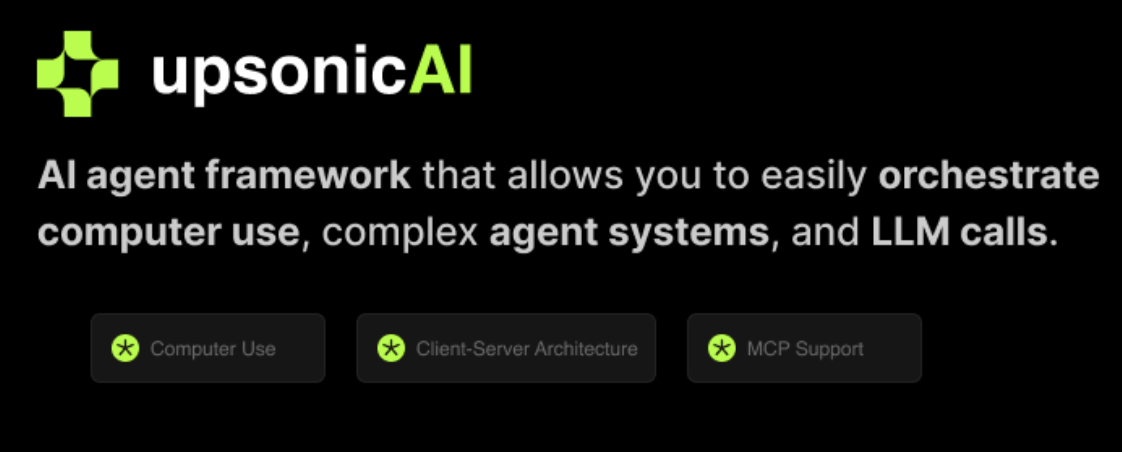Table of Contents
Overview
In the ever-evolving landscape of AI, ensuring reliability and trustworthiness is paramount. Enter Upsonic, an open-source framework designed to bring a new level of confidence to AI agent workflows. By prioritizing reliability from the ground up, Upsonic aims to bridge the gap between cutting-edge AI and dependable, real-world applications. Let’s dive into what makes Upsonic a compelling option for those seeking robust AI solutions.
Key Features
Upsonic boasts a suite of features designed to enhance the reliability and validation of AI agent outputs:
- Reliability-first design: Built with a core focus on ensuring the dependability of AI agent workflows. This foundational principle guides the entire framework.
- Output verification layers: Multiple layers of validation are applied to agent outputs, catching errors and inconsistencies before they impact downstream processes.
- Validator agents: Secondary AI agents are deployed to independently verify the outputs of primary agents, providing an unbiased assessment.
- Evaluation systems: Runtime evaluation systems continuously monitor agent performance, identifying potential issues and triggering alerts.
- Open-source framework: Upsonic is freely available and modifiable, fostering community collaboration and transparency.
- Supports real-world applications: Designed to handle the complexities and demands of real-world scenarios, making it suitable for enterprise-level deployments.
How It Works
Upsonic employs a layered approach to ensure the validity of AI agent outputs. The process begins with the primary AI agent generating an output. This output then passes through a series of output verification modules, each designed to identify specific types of errors or inconsistencies. In addition, validator agents, acting as independent assessors, double-check the primary agent’s work. Finally, integration with runtime evaluators allows for dynamic assessment of agent performance, providing real-time feedback and flagging potential issues. This multi-faceted validation process significantly enhances the reliability of AI agent workflows.
Use Cases
Upsonic’s reliability-centered design makes it suitable for a variety of applications:
- Enterprise automation: Automate complex business processes with confidence, knowing that Upsonic’s validation mechanisms are in place.
- AI agent reliability testing: Thoroughly test and validate the performance of AI agents before deployment, identifying potential weaknesses and vulnerabilities.
- Workflow orchestration: Seamlessly integrate AI agents into existing workflows, ensuring consistent quality and reliability across the entire process.
- Quality assurance in AI outputs: Implement robust quality assurance measures for AI-generated content, minimizing errors and improving overall accuracy.
- Safe AI deployment: Deploy AI solutions with greater confidence, knowing that Upsonic’s validation mechanisms are actively mitigating risks.
Pros & Cons
Advantages
- High reliability: Upsonic’s layered validation approach significantly enhances the reliability of AI agent workflows.
- Open-source and transparent: The open-source nature of Upsonic promotes transparency and community collaboration.
- Modular design: Upsonic’s modular design allows for easy customization and integration with existing systems.
- Community supported: Benefit from the collective knowledge and expertise of the Upsonic community.
Disadvantages
- Requires setup and integration knowledge: Implementing Upsonic requires a certain level of technical expertise.
- Limited documentation: The documentation for Upsonic is still evolving, which may pose challenges for some users.
- Still evolving: As a relatively new framework, Upsonic is still under active development.
How Does It Compare?
When considering AI agent workflow frameworks, it’s important to understand how Upsonic stacks up against the competition. LangChain offers a broader toolkit with a wider range of functionalities, but it is less focused on reliability and structured validation. AutoGPT, on the other hand, is more experimental and less structured in its validation approach compared to Upsonic’s reliability-first design. Upsonic distinguishes itself by prioritizing robust validation mechanisms and a structured approach to ensuring the trustworthiness of AI agent outputs.
Final Thoughts
Upsonic presents a compelling solution for those seeking to build reliable and trustworthy AI agent workflows. Its open-source nature, layered validation approach, and focus on real-world applications make it a valuable tool for enterprises and developers alike. While it requires some initial setup and integration knowledge, the benefits of enhanced reliability and confidence in AI outputs make Upsonic a worthwhile investment. As the framework continues to evolve and mature, it has the potential to become a leading solution for ensuring the safe and dependable deployment of AI.
